Blue’s versatility makes it one of the most commonly used colors on a painter’s palette – and expanding your ability to create various shades of blue will elevate your work to a new level.
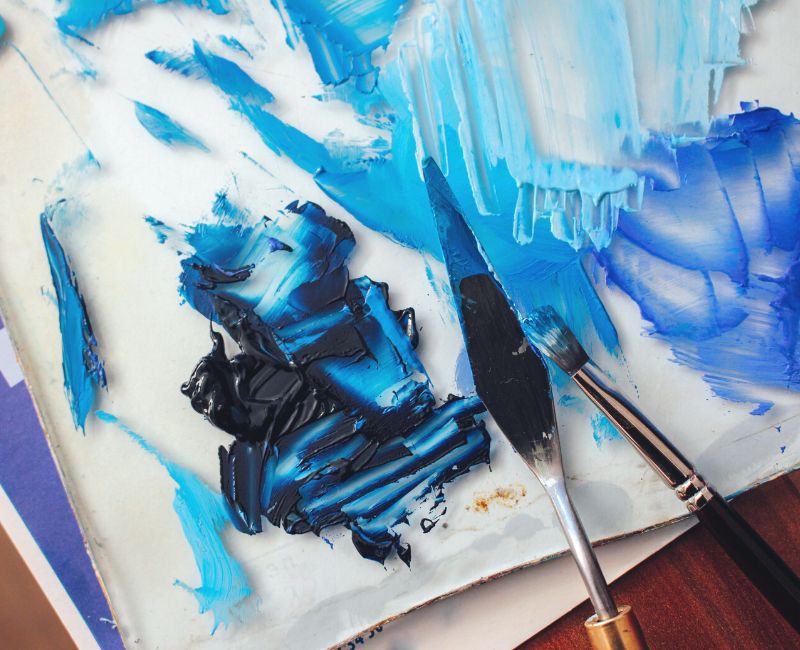
In this article, you’ll delve into the nuances of what colors make blue different shades, from light and warm to dark and muted. Discovering the colors that make blue and learning how to mix them expertly, is exactly what this guide will help you to uncover.
What colors make blue (explained)
Blue is a primary color that cannot be created by mixing other colors. This is where the art of color mixing comes in, whereby it’s possible to learn how to create multiple shades of blue using different colors such as; orange, green, white and many others.
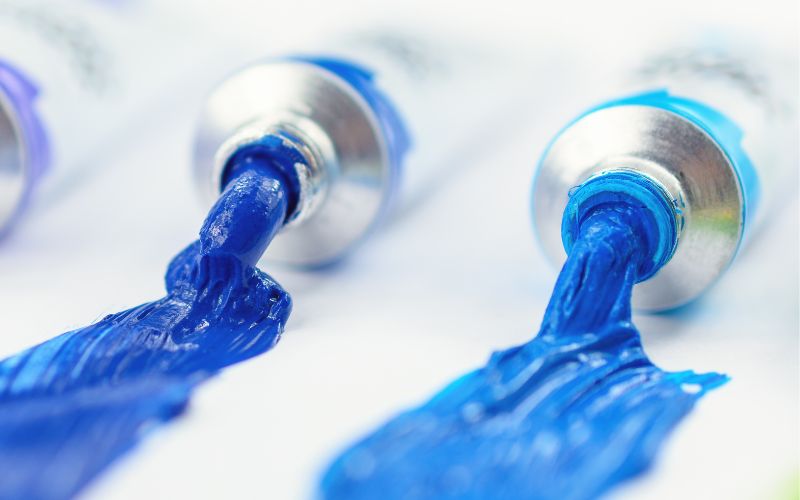
This is exciting, and we will start by learning how to create light blue colors.
How to make blue lighter in value

You will run into many situations in which you will need to know how to make blue colors that are lighter. Below is a chart that will show you how to mix different kinds of lighter blue colors using both ultramarine blue and cobalt blue
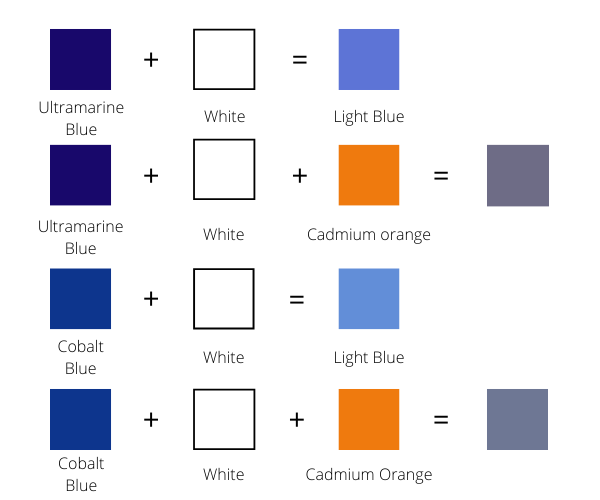
You will see above, that I used ultramarine blue in the first two color mixtures and cobalt blue in the last two color mixtures. To make blue lighter I simply mixed blue with white. The result is a bright saturated color.
How to mix (muted) light blues
Ultramarine blue and cobalt blue are very bright saturated colors when mixed with white. Therefore, I show a muted blue by mixing a little bit of orange with blue. When mixing orange with a lighter blue you get a light blue that is slightly muted as seen in the second and fourth lines.
When the blue is lightened with white you can more readily notice how ultramarine blue is warmer (leans toward purple) while cobalt blue is cooler (leans slightly more towards green). You can observe the difference between both blue colors in all of the color charts below.
How to make dark blue colors
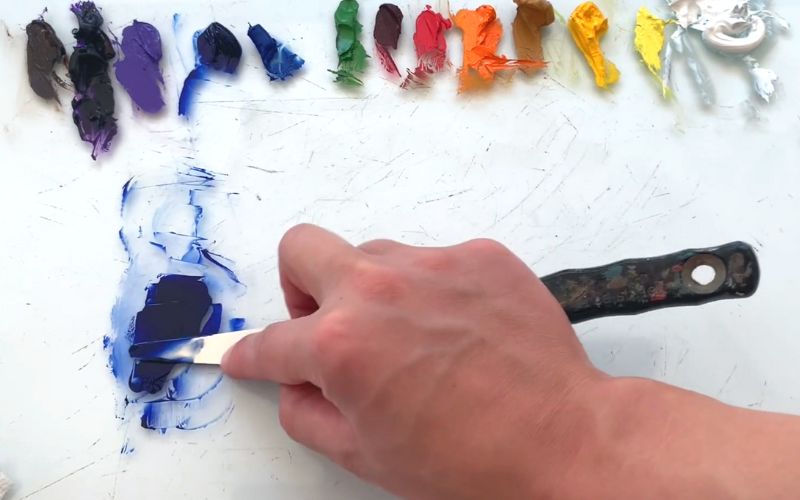
In the color chart below, you’ll see exactly what colors make blue darker. Because Ultramarine blue is already a very dark color, I’ll be showing you how to make other wonderful dark blue colors with it. Also, if you haven’t already – you can grab my FREE Color Mixing Guide for helpful color mixing instructions and techniques!

Mixing Dioxazine Purple and Blue
As seen in the first line dioxazine purple and ultramarine blue make an excellent dark color. Not only does dioxazine purple make ultramarine blue darker but it also adds a little purple shade to it.
Dioxazine Purple + Pthalo Green Option
On the second line (in chart above), you will see how to make dark blue using ultramarine blue mixed with dioxazine purple as well as pthalo green. Pthalo green is a dark color that will darken the blue/ purple mixture more while adding a slight green tinge to it.
Use Burnt Umber for a Dark, Muted Blue
Not only does burnt umber mixed with ultramarine blue create a dark blue color but it also makes a great muted blue. So, if you want to have a dark blue that is not a very saturated (bright) blue – then burnt umber is a great option to mix it with.
Pthalo Green and Alizarin Crimson
When mixing pthalo green and alizarin crimson together you get a lovely black color. This can also be seen in the black color mixing guide. So, when you want to get a rich dark blue, then mix pthalo green and alizarin crimson with ultramarine blue. This will give you one of the darkest and most interesting blue colors.
How to make muted shades of blue
I spend a great deal of my mixing time, muting blue colors. As I rarely use blue colors that are straight from the tube for anything. If you have used ultramarine blue and cobalt blue you will know that they are very bright colors, and a well constructed painting demands a variety of muted colors. So, let’s dig in and learn how to make blue colours that are muted!
Using Complementary Colors
Complementary colors are very important when it comes to mixing muted colors. A complementary color is the color that is opposite it on the color wheel. So when looking at the color wheel below, you can see that purple is directly across from yellow – therefore yellow and purple are complementary colors. Additionally, orange is directly opposite from blue. Therefore, blue and orange are complementary colors.

Muted Shades of Blue Color Charts
Since orange is the complementary color of blue it is put into action in the color chart below. Color mixing tip: in addition to creating multiple shades of muted blue colors – you can mix blue and orange together to make a nice shade of brown.

Ultramarine Blue & Cobalt Blue Mixed with Orange
In the first line you can see cadmium orange mixed with ultramarine blue. Mixing the orange into the blue takes away the brightness of the blue by making it into a ‘dull’ color. In other words, mixing orange into the blue made the blue less blue! This is exactly what happens when one mixing two complementary colors together – as explained above with the color wheel.
However, the warning is not to mix too much orange with your blue as it will end up looking a little bit green. If this does happen just mix in more blue to counteract the orange.
Burnt umber + Ultramarine Blue/ Cobalt blue
Next option for muting blue is to mix burnt umber with blue. I personally always prefer to mix orange with blue as this creates for a much more interesting and richer muted blue. Burnt umber on the other hand creates more of a brownish blue. That said, there are definitely times when you will need a muted brownish blue. In those moments remember this mixture.
How to mix warm shades of blue colors
Blue is generally considered a ‘cool color’. However temperature is relative when it comes to colors. So, it is possible to mix warm shades of blue colors.

Ultramarine blue is already a warm blue as it leans more toward purple when compared with other blue colors. However, there are always instances when you might need to make an even warmer blue.
The first option – mixing alizarin crimson with blue makes for a purpleish blue. Ultramarine blue ends up being much more purple than the cobalt blue mixture since ultramarine already leans toward purple to begin with.
The next option is to mix burnt umber with blue – a mixture we have already talked about. However, this mixture is also great for mixing a warm blue color.
Lastly, you can mix green (cadmium green or a green of your choice) with blue. This mixture does not create a blue that is as warm as if you mixed it with burnt umber or alizarin crimson. However, it is a good option for when you do not need a blue that is overly warm.
Warm shades of blue with Cobalt Blue
Below is the same color chart as the one above – however the ultramarine blue is substituted with cobalt blue. Cobalt blue is a cooler blue than ultramarine blue. So, the blue mixtures below from the color combinations are not quite as warm as when mixed with ultramarine blue.
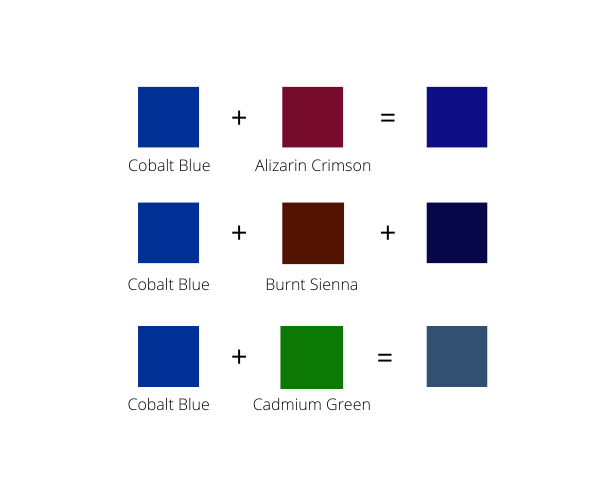
Mixing turquoise blue colors
Have you ever seen those beautiful blue/ turquoise ocean waters? Or perhaps a blue sky that almost seems to have a little bit of yellow in it? You cannot get these colors without a little bit of green… so here I introduce some different shades of blue colors by mixing the color green with blue!

Mixing blue with cadmium green
I first mix ultramarine blue and cobalt blue with cadmium green. You can see that the result is a blue that has a tinge of turquoise to it. To make it lighter I mix a little bit of white to the blue/ cadmium green mixture. The result is a lighter blue that leans toward turquoise.
Mixing blue with veronese green
Next I mix shades of blue colors with veronese green – a bright cool green. This creates a very interesting turquoise blue that retains more of its “blueness” than when mixed with cadmium green. Both the ultramarine blue and cobalt blue when mixed with veronese green made for rich colors. When lightening the veronese green/ blue mixtures with white the result was lighter but equally rich colors.
Examples of different shades of blue colors in art
Not all blue mixtures will be as straightforward as what I described in the color charts. However the color charts will help to guide you down the path to learning how to mix colors. To achieve certain colors sometimes a much more complex color mixing is required.
I have a few paintings here done by myself in which I will share how I mixed certain colors – so you can see what mixing blues in real life looks like.
Mixing blue color using cobalt blue

Here are some examples of mixing different shades of blue using cobalt blue (as well as some ultramarine blue). The colors in this piece are generally closer to the the cobalt shade of blue than ultramarine blue (ultramarine leans more toward purple). Notice that a little bit of cadmium green is used as well.
Mixing dark and muted shades of blue color
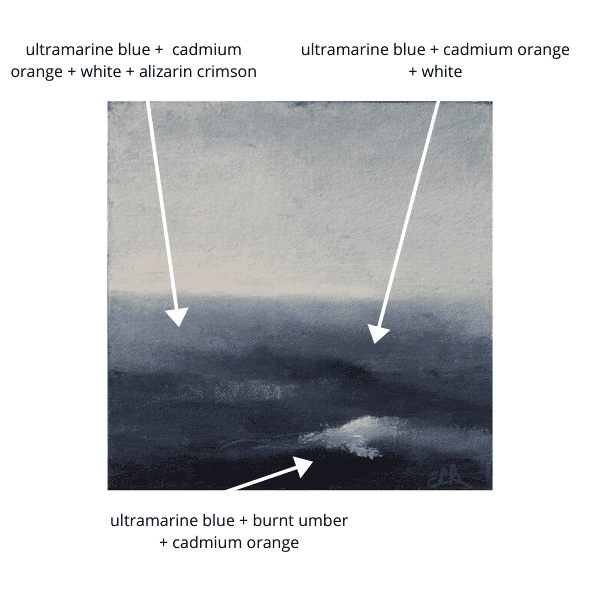
This piece has a lot of very dark shades of blue. The blue on the bottom area of the painting is the darkest (you might be surprised how dark burnt umber mixed with ultramarine blue can get)! When making lighter blues for the other two mixtures. I make sure that the color is muted enough by mixing in orange to my blue. Often when making blue lighter, it can create a very bright blue. So, it is important to mix in enough cadmium orange to mute it enough for this painting.
Mixing warm shades of blue color
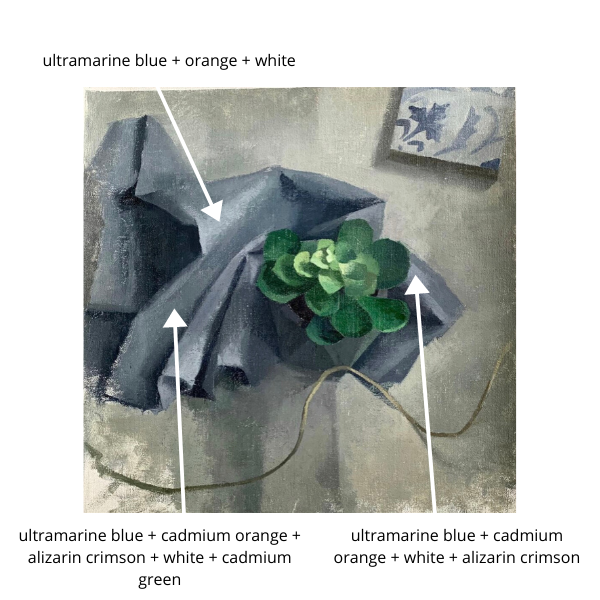
This painting has a lot of blues that lean towards purple. I used a lot of ultramarine blue and even a little bit of alizarin crimson – which helped to make the blue shades even more purple like. I also used a little bit of green for some of the green for the lower left color. Speaking of green – you can of course use blue to make green. However, there are several other lovely shades of green you can make with blue in addition!
Now, over to you!
Through painting, you’ll come to see how central blue is to your craft. Next time there’s an abundance of blues before you, take time to appreciate their subtleties — experiment with the variety of shades you can create. You’ll be amazed at the dimension and depth you can add to your work with just a little extra attention to this important color.

Also, give yourself the freedom to experiment with different color combinations – you will be surprised at the varieties of colors you will get by mixing together different colors!
Other color mixing article guides for you:
Want to remember this? Save How to Make Shades of Blue Color to your favorite Pinterest board!



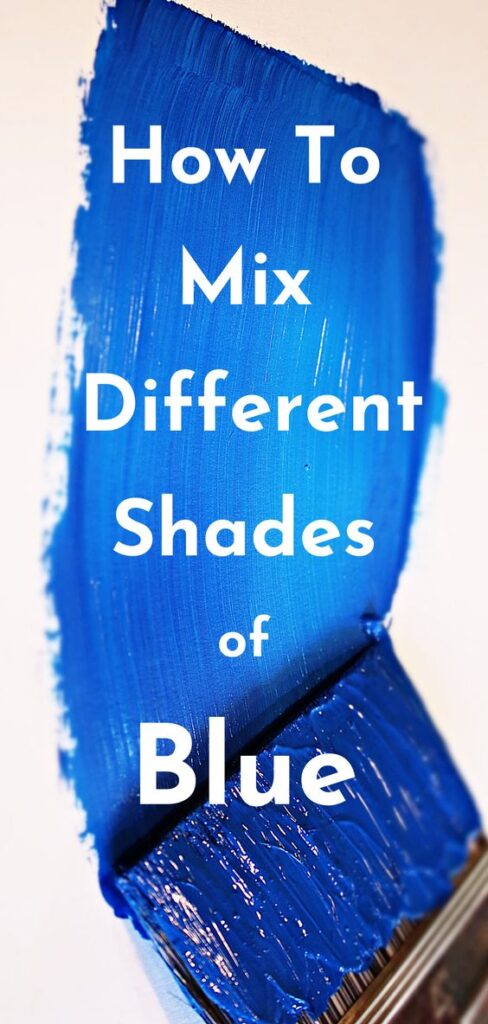





28 thoughts on “What Colors Make Blue and How to Make Shades of Blue Color”
Do you have an actual print copy of this tutorial that I can buy? Thank you. So helpful!
Hi Suzanne, All of my color mixing information can be found in my Color Mixing Master Guide in eBook format 🙂 So glad this is helpful – thank you for sharing.
Thank you so much….I’ve been struggling to get a certain shade of turquoise and now I’ve got !
Glad to hear this was helpful!
Hello, Elisabeth! Thank you very much for sharing this knowledge with us. A big hug.
You are so welcome, am glad it is helpful 🙂
Your color mixing charts and articles are extremely helpful. I’m not mixing paints but rather ink, extremely different due to proportioning, but the general idea is the same as far as which colors make which.
The problem I’m having is making cobalt from a light blue called Caribbean blue. thank you very much.
Hi Dwaine, Am very glad that my color mixing charts have been helpful with figuring out colors!
Thank you. This is so detailed. Just have to play around with colors. I do watercolors. I guess the guide would be for all paint mediums
Hello Nalini, You are so welcome! Yes, the guide works for all paint mediums 🙂 That is wonderful that you paint with watercolors – they are a beautiful medium.
I am a self learning hobby-painter, only interested in temperate mountain landscapes. Created a few that looked good and were appreciated by my circle of friends, But the water color paints in the market are really toxic and I wast quite disturbed by these paints. So I gave up the painting. I am now again trying my hand on paintings by using home made non-toxic paints. Will it really work? Your comments please.
makawosa from Kashmir Himalayas.
Hi Makawosa, Thank you for your comment and question. That is great that you are getting back into painting and making your own paints. You certainly can successfully do that! Just make sure that the ingredients you are using make the paint archival as you wouldn’t want your painting to fade! I have found that ‘Natural Earth Paint’ has some helpful information on natural paint making.
I also have a few natural paint making tutorials. These are not archival – but can be fun to use:
Instant coffee: https://artstudiolife.com/painting-with-coffee/
Beet vegetables: https://artstudiolife.com/how-to-make-ink/
Really interesting post!
That it was helpful!
Really enjoyed the way you explained using visual aids in mixing warm blues, cool blues and muted blues
Very happy to hear that – thank thank you! Glad you enjoyed the article.
After a layoff of 20 years or more I decided to try to paint again. As I never took any lessons and did not paint all that much even back then.
When I started to purchase paints, etc. I found that a lot had changed.
Without going into great detail, needless to say starting over is a challenge but one that I am really enjoying.
As to the reason for my post, I just wanted to let you know how much your site is of great help answering many question I have.
I forgot to let you know what type of paint I am using,{Acrylic}.
Thanks again, looking forward to your next message.
CWB
Thank you for sharing! I am glad to hear that the information on the website is helpful – that is wonderful. Do continue on growing in your painting!
Thank you so much.
I still want to get the right color mix of the light purple to be dark bluish.
Glad the article was helpful!
Thank you very much for this post. It is very interesting and helpful to me as a hobby artist. I am very satisfied with your clear instructions. Very kind of you the offer. Greetings from Greece
I am very glad that it was helpful to you!
Thought this information was very helpful!
Thank you Abbi, I am glad that you found it helpful!
Thanks again Elisabeth, great stuff.
regards
Warren
Thank you Warren! Glad it is helpful.
Hello Elisabeth, thanks for a very helpful post. I am always looking to be able to mix from limited palettes, it is a very interesting string to have in your bow. You can never have to many of those can you ?
I am what the upper crust of the art world would call a hobby artist, but I am at the stage where I am chuffed with my own work sometimes, thinking that some of my stuff is almost good enough to sell. Good feeling.
Please keep these types of posts coming, I, for one ,really appreciate them. Who can afford painting lessons , right ?
Thanks again, Dave M😎🇦🇺
Hello Dave,
Thank you for your kind words! I am glad that this post is helpful. It is such a satisfying feeling when you get to a stage that you start feeling more satisfied about the work you are creating – that is wonderful!
More posts are coming 🙂